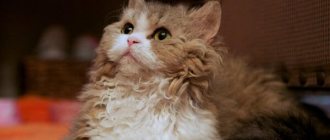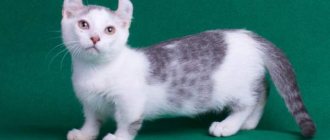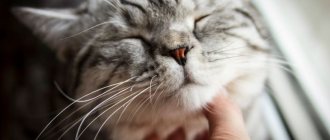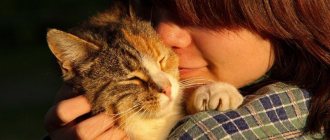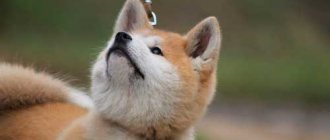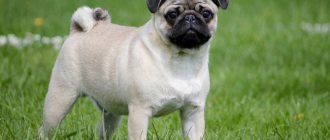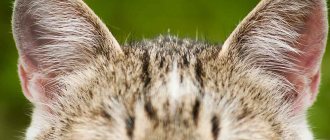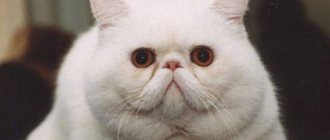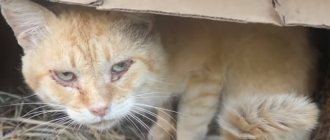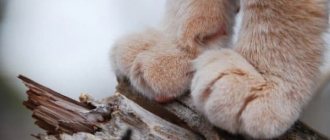Origin story
Until the end of the 80s. Most experts believed that the short-legged animal was inferior and unhealthy. The Munchkin, as an independent variety, began to develop in 1983.
In Louisiana, Sandra Hochenedel picked up a street cat with abnormally short legs. The woman believed that this feature was related to her lifestyle: she ate poorly and could not develop normally.
However, the cat gave birth to kittens with the same short legs. The owner was very surprised and gave one female from the litter to her friend. After a while, she also gave birth to short-legged babies. Sandra thought about this amazing phenomenon and turned to a veterinarian.
Studies were carried out, after which the veterinarian concluded that the peculiarity of the structure of the animal’s legs was due to a mutation in the genetic code. It was found that this is not a defect and does not affect health.
The description of the Munchkin breed was compiled two years after the appearance of the first offspring. Many breeders continued to consider the animals inferior and ugly. However, in 1995 they began to be presented at exhibitions.
History of the breed
Selection is not how munchkins became part of the animal kingdom. Journalists began writing about the spontaneous mutation, which was noticed by European residents, in local publications about 100 years ago. Increased attention has led to the fact that owners of an unusual genome have become frequent subjects of newspaper publications. The interest was impressive, but not long-lasting, since World War II led to the mass death of dwarf cats. Soon interest in them faded. Changing lifestyles and extermination were precisely the reasons why this variety could not be patented in the 20th century.
Munchkins appeared about a hundred years ago
However, dwarf cats did not stop being born, so inquisitive breeders began to mate them with other breeds that had full limb length. The experiment led to interesting results - almost all the offspring obtained in this way had a shortened paw structure. The original method of breeding is the reason why munchkins have a varied appearance and are very similar to representatives of other cat breeds.
The increase in the number of short-legged animals raised the question of recognition of the new species by well-known federations. Soon, munchkins were approved by LOOF, WCF, as well as TICA, which in 1991 (USA) presented this species at an exhibition as an official breed. In Russia, pets of this type began to be bred only in the 21st century, so the domestic public still knows little about them.
Interesting fact. To get short-legged offspring, the owners only need to mate a pair where only one parent has the genetic feature described above.
In Russia, munchkins began to be bred only in the 21st century.
Distinctive features
The breed appeared relatively recently, so its standard has not yet been fully formed. However, the basic characteristics are already there:
| Sign | Description |
| Head | Wide, with smooth outlines, wedge-shaped. Proportional to the body. In adult males it is more developed than in females. |
| Nose | Average, slight bend allowed. |
| Ears | Located high. Fluffy, wide at the base, rounded at the tips. |
| Eyes | They have the shape of a walnut. Located widely, at a slight angle to the ears. The shade depends on the color of the coat. |
| Neck | Thickened and muscular, of medium length. |
| Torso | Medium size. |
| Paws | The hind ones are slightly longer than the front ones. It is permissible to bend the latter towards the inside. Limbs are straight. |
| Backbone | Not heavy, but not lightweight. |
| Muscles | Well developed. |
| Tail | Equal to the length of the body. Stands upright when moving. |
| Weight | In males - 3-4 kg. In females - 2-3.6 kg. |
| Wool | Short: shiny, plush to the touch. Long: dense and silky with a lordly collar. |
| Coloring | Any colors and combinations. |
Munchkin health
Representatives of this breed have fairly good immunity due to the constantly expanding gene pool.
There is one possible disease that can occur in the breed. This disease is lordosis. It appears either as a congenital disease or acquired, for example as a result of obesity. Lordosis is a very large curvature of the spine that disrupts the structure of the body and puts pressure on the internal organs. As a result of the disease, the functioning of not only the body, but also the respiratory and cardiac systems is disrupted.
To avoid diseases common to all cat breeds, you need to give your cats vaccinations and the necessary procedures in advance. This will not only prevent disease, but will also prolong the life of your pet.
Nutrition
The number of meals depends on the age of the pet:
- up to four weeks - five times a day;
- from twelve weeks to one year - three or four times;
- adults - twice.
Up to four months it is necessary to give porridge, meat, and fermented milk products. The diet of adults includes vegetables and fish fillets.
Premium dry and wet food and holistic foods are recommended.
Required products on the menu:
- unsweetened fermented milk products without dyes and synthetic thickeners;
- dietary meat;
- sea fish;
- cereals, excluding legumes;
- vegetables, except potatoes;
- chicken and quail yolks;
- meat by-products (for example, liver).
Fish and meat should be boiled and mixed into porridge. Vegetables are not fully digestible by animals. This must be taken into account when creating a menu.
Hygiene
Munchkins come in long-haired and short-haired varieties. Pets should be combed with a slicker brush, comb, or brush. The movement is from head to tail. Done once a week.
Wash cats if necessary. A special shampoo is used, selected according to the type of coat and skin. After bathing, the pet is dried with a soft cloth or dried with a hairdryer.
Munchkin's eyes are treated with a cotton pad soaked in boiled water or tea. Teeth are brushed every two weeks with cat toothpaste. Wax and accumulations of dirt from the ears are removed with cotton swabs with a special solution or drops, Vaseline. The claws are trimmed as they grow with a nail clipper.
Interesting facts about munchkins
In addition to short legs, the breed has some other features and interesting facts:
- Despite their short legs, the seals are very active and fast.
- The short paw mutation turned out to be completely spontaneous.
- During the Second World War, the breed was called “Stalingrad Kangaroos” because of its love of sitting on its hind legs, folding its short front legs.
- The smallest cat in the world is Lily. Her height is only 13.5 centimeters. It is not surprising that it was the munchkin who received this title and is included in the Guinness Book of Records.
The smallest cat is the Munchkin cat.
- The breed has a lot of nicknames: dwarf cats, catgnomes, dachshund cats, sausage cats, kangaroo cats and even magpie cats because of their love of carrying all sorts of things.
- The name "munchkin" comes from the characters in Lyman Frank Baum's book The Wizard of Oz. This was the name of the dwarf people from the work.
- Munchkins hardly make any sounds. It is believed that they meow less often than other breeds.
- Cats are very popular even among celebrities. Paris Hilton has two cats of this breed.
Health
Munchkins are hardy and healthy. They have a strong immune system and no predisposition to severe genetic pathologies.
A hereditary disease to which the breed is susceptible is lordosis of the spine in the form of its stretching in the thoracic region.
The pathological condition provokes problems with the heart and lungs. Most often, the disease manifests itself in obesity or genetic characteristics. Therefore, it is important to monitor your pet’s diet and carefully choose a partner when mating.
Breed faults:
- convex chest;
- too round head and eyes;
- absence of tail, fingers, polydactyly;
- snub or elongated nose;
- “cow set”;
- short, very stocky body;
- curly hair;
- concave back, drooping croup;
- absence of testes;
- blindness and strabismus.
Also, a cat will be disqualified at an exhibition if it has a difficult character, cowardice, or aggressiveness.
Popular colors
Among individuals of the munchkin color there are a variety of colors; strict standards for this characteristic have not been established. There are both long-haired cats and those with short hair. This is due to the natural nature of the mutation. If a breeder had intervened in the breed, the number of colors would have been limited.
Munchkins are compared to ordinary yard cats who were lucky enough to become famous due to their anomaly. At exhibitions you can see pets of colors ranging from bright red to solid gray. Tricolor, bicolor, as well as colors with spots and stripes are acceptable.
The breed is currently in its infancy. Perhaps, soon the requirements for standards will be tightened and the federations of felinologists will approve some specific colors.
Representatives of this color are often crossed with Scottish and Bengal cats. The result is short-legged “Scots” and “Bengalis”. In Berlin in 2021, a cat family was presented to the public, which is the result of mixing munchkins and sphinxes. These cats had short front legs, a miniature body and no hair.
Fans of the breed especially appreciate the chocolate and marbled colors. Such pets are born only in nurseries. With the current trend of kitten breeding, there will soon be a lot of chocolate and marbled animals.
Advantages and disadvantages
The breed has many more positive aspects than negative aspects:
| Advantages | Flaws |
| Obedient, good-natured, smart. | They have a habit of hiding things. |
| They calmly accept changes and new surroundings. | They don't catch rodents. |
| They rarely get sick. | You should not be allowed out for walks unattended. |
| They don’t jump on tables or cabinets, so they don’t hit fragile things or steal food. | If you don't hide the toys, they wake you up at night. |
| Do not require special care. | |
| Not picky eaters. | |
| Do not spoil indoor flowers. | |
| They are good with children and other pets. | |
| Not intrusive. | |
| Not aggressive. | |
| They rarely meow. |
Character and behavior
These cats have a surprisingly easy character. They look at the world like children - with their eyes wide open and not expecting a catch. They love active games, and their short legs do not prevent them from making dizzyingly high jumps and racing throughout the apartment. This playfulness remains with them until death.
Curiosity is one of their main traits. Munchkins especially love small objects that can be rolled and carried from place to place. So keep in mind: if your favorite flash drive or lipstick has disappeared from the table, ask your restless pet for the item.
There is not a drop of aggression in these cats. Both adults and children are friends and buddies for them, from whom cats expect only affection. Munchkins are not afraid of strangers and are happy to go out to meet guests. They are very careful with children and do not allow themselves to let out their claws, even if they are hurt.
Travels (even long distances) stand up well. If the beloved owner is nearby, the cat will easily endure both the trip and the flight. And he adapts quickly to a new place.
They get along well with other animals, do not show aggression towards creatures smaller than themselves: fish, birds and rodents, but in case of danger they can quite stand up for themselves.
They quickly get accustomed to the tray, eat carefully and in general are very clean animals. They don’t damage the furniture, provided they have a comfortable scratching post. Regarding the tray: buy a deep and wide container. A diligent munchkin, in an attempt to bury waste as deeply as possible, can litter the floor.
A funny feature of munchkins leaves no one indifferent: if the cat wants to look at something, it tucks its tail under itself and sits in a “column”, like a gopher. Moreover, a cat can sit like this for a very long time (the physiology of munchkins allows them to do this without harming themselves).
In the eyes of other cats, a short munchkin may look like it is preparing to attack, so do not let it out of sight while walking, and even more so, do not let it walk alone. This can be extremely dangerous.
What does this pose mean in cats: crouching to the ground, arching their back, starting a mournful song?
Mating gamesPreparing for a fight
Price
When deciding to buy a kitten, you need to pay attention to the following:
- age of parents;
- number of matings between father and mother;
- diseases of parents, hereditary pathologies;
- features of pregnancy and childbirth;
- absence of individuals with extra toes in the litter;
- availability of certificates of vaccinations and deworming in accordance with age;
- sterilization and castration;
- behavioral characteristics of the kitten and its parents;
- food given to the animal;
- content rules.
A kitten without documents costs between 15-25 thousand rubles. Purebred individuals - 40-60 thousand rubles. The price of animals in high-level nurseries is determined by experts.
Lilieput – Shortest Cat Guinness World Records 2014 Photo Credit: James Ellerker/Guinness World Records
